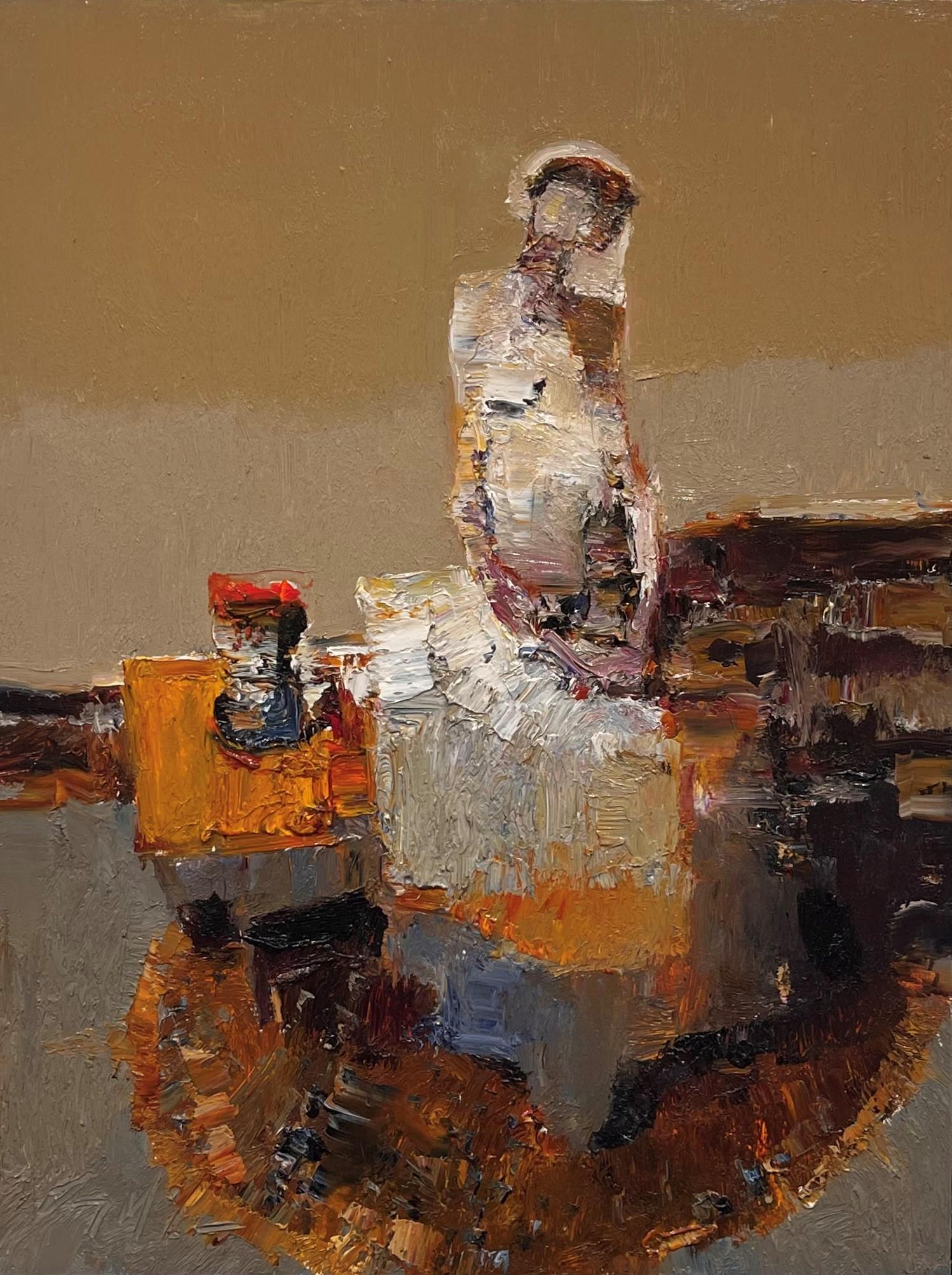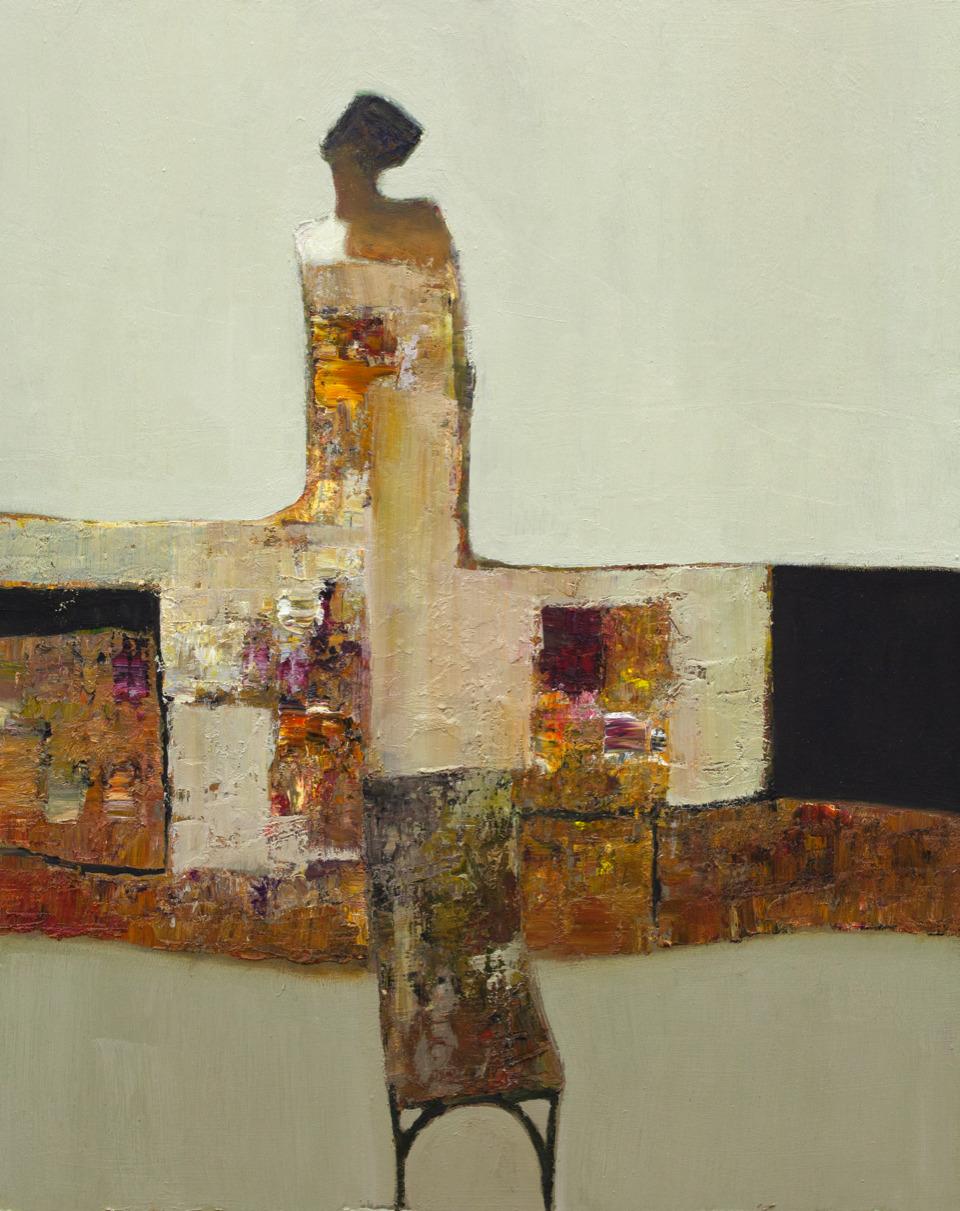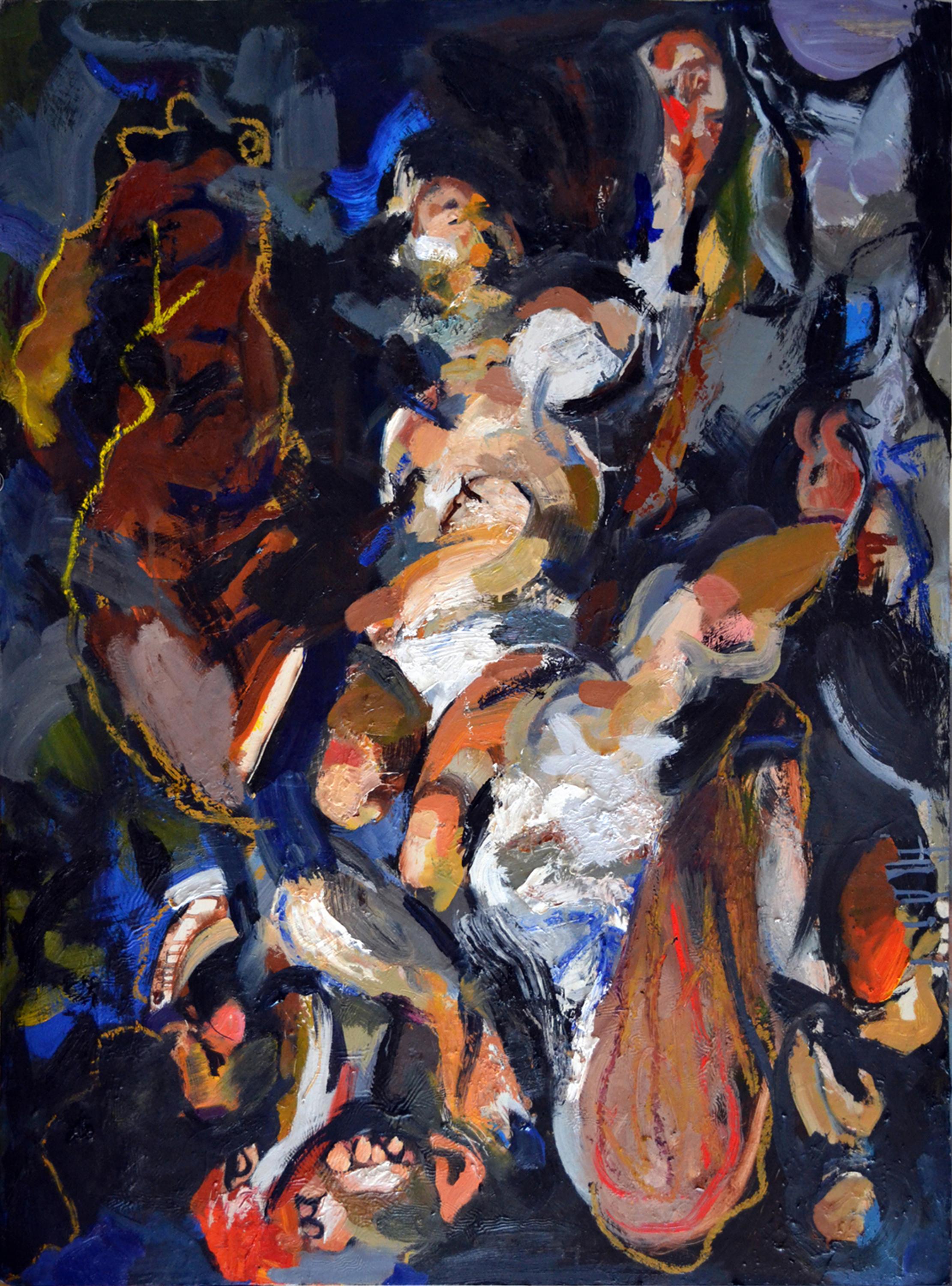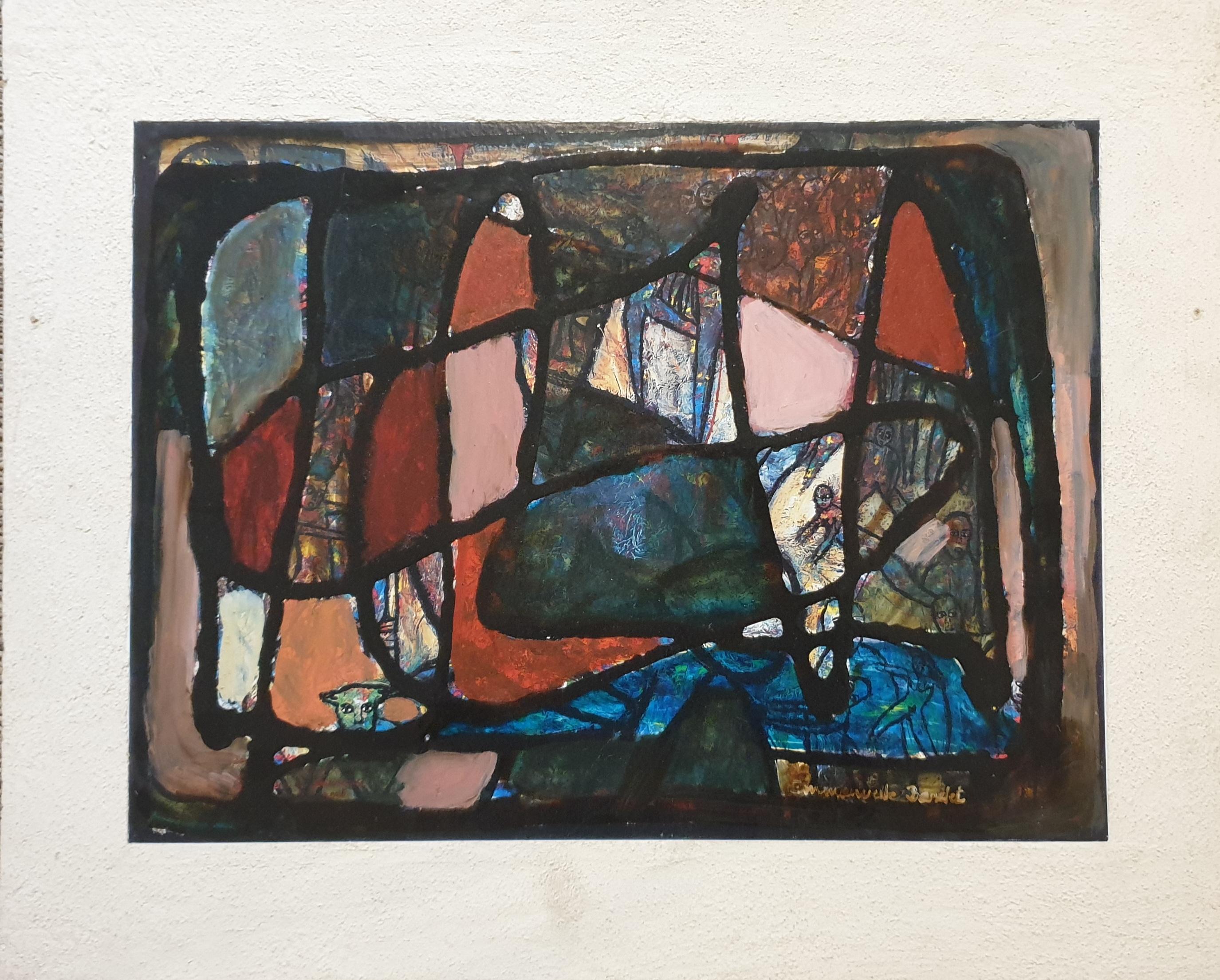Items Similar to 1950s Abstract Painting New York Skyline Cityscape, Buildings, Blue Yellow Red
Video Loading
Want more images or videos?
Request additional images or videos from the seller
1 of 15
Charles Ragland Bunnell1950s Abstract Painting New York Skyline Cityscape, Buildings, Blue Yellow Red1951
1951
About the Item
Vintage 1950s original signed abstract painting of New York City by Charles Ragland Bunnell from 1951, cityscape mid century modern skyline. Presented in a custom black frame, outer dimensions measure 21 ⅜ x 26 ⅜ x 2 inches. Image size is 19 x 24 inches.
Painting is clean and in very good vintage condition - please contact us for a complete condition report.
Expedited and international shipping is available - please contact us for a quote.
About the artist:
Charles Bunnell developed a love for art at a very young age. As a child in Kansas City, Missouri, he spent much of his time drawing. When he was unable to find paper he drew on walls and in the margins of textbooks for which he was often fined. Around 1915, Bunnell moved with his family to Colorado Springs, Colorado. He served in World War I and later used his GI Training to study at the Broadmoor Art Academy (later renamed the Colorado Springs Fine Arts Center) during 1922 and 1923.
In 1922, he married fellow student, Laura Palmer. He studied with Ernest Lawson in 1927-1928 and, in the winter of 1928-1929, he served as Lawson’s assistant. In the late 1920’s, the Bunnell’s settled just west of Colorado Springs and 1928, they welcomed the first of their three children. Their one-acre homesite, which they referred to as “Old Home Place”, was situated between two sets of railroad tracks at the foot of Pike’s Peak. Charlie converted an old railroad boxcar into his studio, where he later gave lessons.
Beginning in 1931, Bunnell spent a year and a half studying under Boardman Robinson. The two men clashed constantly due to a generation gap and markedly different philosophies. Robinson encouraged his students not to stray from realism and though Bunnell mastered Robinson’s preferred style of American Scene painting, he regularly irritated his professor with his abstract sketches.
Bunnell taught at the Kansas City Art Institute during the summers of 1929, 1930, 1940, and 1941. Between 1934 and 1941, he painted and taught under federal projects which included assisting Frank Mechau on murals for the Colorado Springs Post Office. However, he did not take to mural making and, after criticism from Boardman Robinson about his use of “heavy daubs which have no place in mural work,” he abandoned mural-making altogether.
By the late 1930’s, Bunnell’s work departed from the American Scene/Modernist style he was trained in towards abstraction. This is marked by his “Black and Blue” series, consisting of 83 abstracted ink and watercolors. Affected by the Second World War and the loss of his 10-year old son, Bunnell’s work of the early 1940’s took on a Transcendental and Surrealist tone. The works from this period are moody and readily reflect the political and personal turmoil experienced by the artist.
In the late 1940’s, Bunnell began experimenting with Abstract Expressionism. He alone is credited with introducing Colorado Springs to the new style as it was excluded from the Fine Art Center’s curriculum by Boardman Robinson. Bunnell excelled in Abstract Expressionism and continued to evolve in the style through the 1950’s continuing to his death in 1968. He was recently recognized as a premier American Abstract Expressionist by his inclusion in the book American Abstract Expressionism of the 1950’s: An Illustrated Survey.
©David Cook Galleries, LLC
- Creator:Charles Ragland Bunnell (1897-1968, American)
- Creation Year:1951
- Dimensions:Height: 21.5 in (54.61 cm)Width: 26.5 in (67.31 cm)Depth: 2 in (5.08 cm)
- Medium:
- Movement & Style:
- Period:
- Condition:very good to excellent vintage condition.
- Gallery Location:Denver, CO
- Reference Number:
About the Seller
5.0
Platinum Seller
These expertly vetted sellers are 1stDibs' most experienced sellers and are rated highest by our customers.
Established in 1979
1stDibs seller since 2013
264 sales on 1stDibs
Typical response time: 5 hours
- ShippingRetrieving quote...Ships From: Denver, CO
- Return PolicyA return for this item may be initiated within 7 days of delivery.
More From This SellerView All
- Nude Side View, Abstract Figurative Oil Painting of a Female Figure, Pink BlueBy Martin SaldanaLocated in Denver, COAbstract figurative nude portrait of a female surrounded by birds and floral arrangements, oil on board by Martin Saldana (1874-1965) titled 'Nude Side View'. Presented in a custom frame measuring 28 ¾ x 21 inches; image size is 20 ¾ x 13 ¾ inches. Painting is in good condition - please contact us for a detailed condition report. About the Artist: Born Mexico 1874 Died 1965 Born in 1874, Saldaña grew up at Rancho Neuvo in Mexico. In 1950, at the age of 76, he began attending children's art classes at the Denver Art Museum. For the next fitfteen years, Saldaña Imaginatively documented whimsical memories from his childhood in San Luis Potosi, Mexico, portraying ranch life, landscapes, and his great love of animals. The prolific artist painted every day, completing a new piece about every three days and amassing an impressive body of work for the former cook at the Denver landmark, the Brown Palace...Category
Early 20th Century Abstract Figurative Paintings
MaterialsOil, Board
- New York City Abstract Skyline, Semi Abstract Night Scene Cityscape Oil PaintingBy Charles Ragland BunnellLocated in Denver, COOil on board painting of abstracted New York City skyline by Charles Ragland Bunnell from 1951. Nocturne cityscape painted in colors of black, shades of blue, and yellow. Presented in a custom black frame, outer dimensions measure 30 ¼ x 12 ¼ x ¾ inches. Image size is 30 x 12 ¼ inches. Painting is in good vintage condition - please contact us for detailed condition report. Provenance: Estate of Charles Ragland Bunnell Expedited and international shipping is available - please contact us for a quote. About the Artist: Charles Bunnell developed a love for art at a very young age. As a child in Kansas City, Missouri, he spent much of his time drawing. When he was unable to find paper he drew on walls and in the margins of textbooks for which he was often fined. Around 1915, Bunnell moved with his family to Colorado Springs, Colorado. He served in World War I and later used his GI Training to study at the Broadmoor Art Academy (later renamed the Colorado Springs Fine Arts Center) during 1922 and 1923. In 1922, he married fellow student, Laura Palmer...Category
1950s Abstract Abstract Paintings
MaterialsOil, Board
- Masks, 1980s Semi-Abstract Polychromatic Oil Painting, Vibrant MulticolorBy Edward MarecakLocated in Denver, COOil on board painting by Edward Marecak (1919-1993) titled "Masks" from the 1980s. Mosaic style oil painting in vibrant colors of red, blue, green, yellow, and orange. Presented in a...Category
1980s Abstract Abstract Paintings
MaterialsOil
- Winter Witches in an Upside World Interfering with Each Other, Semi-Abstract OilBy Edward MarecakLocated in Denver, COOil painting on burlap by Edward Marecak (1919-1993) titled "Winter Witches in an Upside World Interfering with Each Other" from 1990. Titled and dated by the artist on verso. Painted in shades of black, gray, red, purple, and green. Presented in the original artist frame, outer dimensions measure 44 ⅛ x 44 ⅛ x 1 ⅜ inches. Image size is 43 x 43 inches. About the artist: Edward Marecak Born Ohio 1919 Died Colorado 1993 Born to immigrant parents from the Carpathian region in Slovakia, Marecak grew up with his family in the farming community of Bennett’s Corners, now part of the town of Brunswick, near Cleveland, Ohio. When he turned twelve, his family moved to a multi-ethnic neighborhood of Poles, Czechs, Slovaks, and Slovenians in Cleveland. His childhood household cherished the customs and Slavic folk tales from the Old Country that later strongly influenced his work as a professional artist. During junior high he painted scenery for puppet shows of “Peter and the Wolf,” awakening his interest in art. In his senior year in high school he did Cézanne-inspired watercolors of Ohio barns at seventy-five cents apiece for the National Youth Administration. They earned him a full scholarship to the Cleveland Institute of Art (1938-1942) where he studied with Henry George Keller whose work was included in the 1913 New York Armory Show. In 1940 Marecak also taught at the Museum School of the Cleveland Institute. Before being drafted into the military in 1942, he briefly attended the Cranbrook Academy of Art near Detroit, one of the nation’s leading graduate schools of art, architecture, and design. A center of innovative work in architecture, art and design with an educational approach built on a mentorship model, it has been home to some of the world’s most renowned designers and artists, including Eero Saarinen, Charles Eames, Daniel Libeskind and Harry Bertoia. Marecak’s studies at Cranbrook with painter Zoltan Sepeshy and sculptor Carl Milles were interrupted by U.S. army service in the Aleutian Islands during World War II. Following his military discharge, Marecak studied on the G.I. Bill at the Colorado Springs Fine Arts Center from 1946 to 1950, having previously met its director, Boardman Robinson, conducting a seminar in mural painting at the Cleveland Institute of Art. Although he did not work with Robinson at the Fine Arts Center, who had become quite ill - retiring in 1947 - he studied Robinson’s specialty of mural painting before leaving to briefly attend the Cranbrook Academy in 1947. That same year he returned to the Fine Arts Center, studying painting with Jean Charlot and Mary Chenoweth, and lithography with Lawrence Barrett with whom he produced some 132 images during 1948-49. At the Fine Arts Center he met his future wife, Donna Fortin, whom he married in 1947. Also a Midwesterner, she had taken night art courses at Hull House in Chicago, later studying at the Art Institute of Chicago with the encouragement of artist Edgar Britton. After World War II she studied with him from 1946 to 1949 at the Fine Arts Center. (He had moved to Colorado Springs to treat his tuberculosis.) Ed Marecak also became good friends with Britton, later collaborating with him on the design of large stained glass windows for a local church. In 1950-51 Marecak returned to the Cleveland Institute of Art to complete his Bachelor of Fine Arts degree. A year later he was invited to conduct a summer class at the University of Colorado in Boulder, confirming his interest in the teaching profession. In 1955 he received his teaching certificate from the University of Denver. Vance Kirkland, the head of its art department, helped him get a teaching job with the Denver Public Schools so that he and his family could remain in the Mile High City. For the next twenty-five years he taught art at Skinner, Grove, East, George Washington and Morey Junior High Schools. Prior to coming to Colorado, Marecak did watercolors resembling those of Winslow Homer, John Singer Sargent and Charles Burchfield. However, once in Colorado Springs he decided to destroy much of his earlier oeuvre, embarking on a totally new direction unlike anything he had previously done. Initially, in the 1940s, he was influenced by surrealist imagery and Paul Klee and in the West by Indian petroglyphs and Kachinas. His first one-person show at the Garrett Gallery in Colorado Springs in 1949 featured paintings and lithographs rendered in the style of Magic Realism and referential abstraction. The pieces, including an oil Witch with Pink Dish, foreshadowed the output of his entire Colorado-based career, distinguished by a dramatic use of color, intricacy of execution and attention to detail contributing to their visual impact. He once observed, “Each time I start a new painting I always fool myself by saying this time keep it simple and not get entangled with such complex patterns, color and design; but I always find myself getting more involved with richness, color and subject matter.” An idiosyncratic artist proficient in oil, acrylic, watercolor, gouache, and casein, he did not draw upon Colorado subject matter for his work, unlike many of his fellow painters in the state. Instead he used Midwest landscape imagery, bringing to life in it witches and spirits adapted from the Slovakian folk tales he heard growing up in Ohio. A number of his paintings depict winter witches derived from the Slovak custom in the Tatra Mountains of burning an effigy of the winter witch in the early spring to banish the memory of a hard winter. The folk tale element imparts a dream-like quality to many of his paintings. A devote of Greek mythology, he placed the figures of Circe, Persephone, Sybil, Hera and others in modern settings. The goddess in Persephone Brings a Pumpkin to her Mother, attired as a Midwestern farmer’s daughter, heralds the advent of fall with the pumpkin before departing to spend the winter season in the underworld. Train to Olympus, the meeting place of the gods in ancient Greece, juxtaposes ancient mythology with modernity creating a combination of whimsy and thought-provoking consideration for the viewer. Voyage to Troy #1 alludes to the ancient city that was the site of the Trojan Wars, but has a contemporary, autobiographical component referencing the harbor of the Aleutian Islands recaptured from the Japanese during World War II. In the 1980s Marecak used the goddess Hera in his painting, Hera Contemplates Aspects of the Art Nouveau, to comment on art movements in the latter half of the twentieth century Marecak’s love of classical music and opera, which he shared with his wife and to which he often listened while painting in his Denver basement studio, is reflected in Homage of Offenbach, an abstract work translating the composer’s musical colors into colorful palette. Pace, Pace, Mio Dio, the title of his earliest surrealist painting, is a soprano aria from Verdi’s opera...Category
1990s Abstract Figurative Paintings
MaterialsBurlap, Oil
- The Argument, 1960s Vintage Semi-Abstract Oil Painting in Reds, Pinks, and BlackBy Edward MarecakLocated in Denver, COOil on board painting by Edward Marecak (1919-1993) titled "The Argument" from 1968. Semi-abstract oil painting depicting two figures in colors of greens, pinks, blues, and blacks. Presented framed, outer dimensions measure 49 ½ x 33 ¼ x 1 ½ inches. Image size is 48 x 32 inches. Painting is clean and in very good vintage condition - please contact us for a detailed condition report. About the artist: Born to immigrant parents from the Carpathian region in Slovakia, Marecak grew up with his family in the farming community of Bennett’s Corners, now part of the town of Brunswick, near Cleveland, Ohio. When he turned twelve, his family moved to a multi-ethnic neighborhood of Poles, Czechs, Slovaks, and Slovenians in Cleveland. His childhood household cherished the customs and Slavic folk tales from the Old Country that later strongly influenced his work as a professional artist. During junior high he painted scenery for puppet shows of “Peter and the Wolf,” awakening his interest in art. In his senior year in high school he did Cézanne-inspired watercolors of Ohio barns at seventy-five cents apiece for the National Youth Administration. They earned him a full scholarship to the Cleveland Institute of Art (1938-1942) where he studied with Henry George Keller whose work was included in the 1913 New York Armory Show. In 1940 Marecak also taught at the Museum School of the Cleveland Institute. Before being drafted into the military in 1942, he briefly attended the Cranbrook Academy of Art near Detroit, one of the nation’s leading graduate schools of art, architecture, and design. A center of innovative work in architecture, art and design with an educational approach built on a mentorship model, it has been home to some of the world’s most renowned designers and artists, including Eero Saarinen, Charles Eames, Daniel Libeskind and Harry Bertoia. Marecak’s studies at Cranbrook with painter Zoltan Sepeshy and sculptor Carl Milles were interrupted by U.S. army service in the Aleutian Islands during World War II. Following his military discharge, Marecak studied on the G.I. Bill at the Colorado Springs Fine Arts Center from 1946 to 1950, having previously met its director, Boardman Robinson, conducting a seminar in mural painting at the Cleveland Institute of Art. Although he did not work with Robinson at the Fine Arts Center, who had become quite ill - retiring in 1947 - he studied Robinson’s specialty of mural painting before leaving to briefly attend the Cranbrook Academy in 1947. That same year he returned to the Fine Arts Center, studying painting with Jean Charlot and Mary Chenoweth, and lithography with Lawrence Barrett with whom he produced some 132 images during 1948-49. At the Fine Arts Center he met his future wife, Donna Fortin, whom he married in 1947. Also a Midwesterner, she had taken night art courses at Hull House in Chicago, later studying at the Art Institute of Chicago with the encouragement of artist Edgar Britton. After World War II she studied with him from 1946 to 1949 at the Fine Arts Center. (He had moved to Colorado Springs to treat his tuberculosis.) Ed Marecak also became good friends with Britton, later collaborating with him on the design of large stained glass windows for a local church. In 1950-51 Marecak returned to the Cleveland Institute of Art to complete his Bachelor of Fine Arts degree. A year later he was invited to conduct a summer class at the University of Colorado in Boulder, confirming his interest in the teaching profession. In 1955 he received his teaching certificate from the University of Denver. Vance Kirkland, the head of its art department, helped him get a teaching job with the Denver Public Schools so that he and his family could remain in the Mile High City. For the next twenty-five years he taught art at Skinner, Grove, East, George Washington and Morey Junior High Schools. Prior to coming to Colorado, Marecak did watercolors resembling those of Winslow Homer, John Singer Sargent and Charles Burchfield. However, once in Colorado Springs he decided to destroy much of his earlier oeuvre, embarking on a totally new direction unlike anything he had previously done. Initially, in the 1940s, he was influenced by surrealist imagery and Paul Klee and in the West by Indian petroglyphs and Kachinas. His first one-person show at the Garrett Gallery in Colorado Springs in 1949 featured paintings and lithographs rendered in the style of Magic Realism and referential abstraction. The pieces, including an oil Witch with Pink Dish...Category
1960s Abstract Abstract Paintings
MaterialsOil
- Parcheesi, Vintage Semi Abstract Oil Painting by Edward Marecak, Board GameBy Edward MarecakLocated in Denver, CO'Parcheesi', vintage 1990 semi abstract oil painting on canvas by 20th century Denver artist, Edward Marecak (1919-1993) of a stylized Parcheesi board ...Category
1990s Abstract Abstract Paintings
MaterialsCanvas, Oil
You May Also Like
- "Red Flower", Oil PaintingBy Danny McCawLocated in Denver, CODanny McCaw's (US based) "Untitled" is an original, handmade oil painting with impasto brushstrokes that depicts an ambiguous figure of white and grey sitting in an interior of grey....Category
2010s Abstract Impressionist Abstract Paintings
MaterialsOil, Board
- "Observation" 48" x 36" Oil PaintingLocated in Denver, CODan McCaw's (US based) "Observation" is an original, handmade oil painting that depicts two abstracted figures standing together as the rest of the composition fades into green and w...Category
2010s Abstract Expressionist Abstract Paintings
MaterialsOil, Board
- "Indelible, " Oil PaintingLocated in Denver, CODan McCaw's (US based) "Indelible" is an original, handmade oil painting that depicts an abstracted dark patterned figure standing in a patterned interior setting. Artist Statement...Category
2010s Abstract Expressionist Abstract Paintings
MaterialsBoard, Oil
- "Pete's Going Away, " colorful gestural abstraction, multiple figuresBy Tom BennettLocated in Brooklyn, NYAn abstract figurative oil painting on board. Active, expressive movement with powerful paint application. An abstract homage to Caravaggio.Category
2010s Abstract Impressionist Abstract Paintings
MaterialsOil Crayon, Oil, Board
- "La Corrida", "The Bull Run", French Abstract Expressionist Oil on Board.Located in Cotignac, FRLate 20th century abstract Expressionist oil on board by French artist Emmanuelle Bardet. Signed bottom right and dated 95 and titled "La Corrida" to the reverse along with a dedicat...Category
Late 20th Century Abstract Expressionist Abstract Paintings
MaterialsOil, Board
- Two. 1997. Oil on cardboard, 55x55 cmBy Janis ZemitisLocated in Riga, LVTwo. 1997. Oil on cardboard, 55x55 cm In 1958 he graduated from the Riga Art School of J. Rosenthal, in 1964 Art Academy of Latvian State, painting department, Head of the diploma w...Category
1990s Abstract Abstract Paintings
MaterialsOil, Cardboard
Recently Viewed
View AllMore Ways To Browse
1920s New York
1950 New York City
New York Federal
New York City 1920s
Blue Red 1950s
Old Master Paintings War
Charles Child
Vintage Abstract Art For Wall
City Scapes
City Scape Art
New York Skyline Painting
Vintage Building Sketch
1940s Surrealist Drawing
Train Railroad
Federal 19
David Cook
Railroad Oil Paintings
Vintage Kansas City





